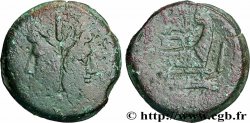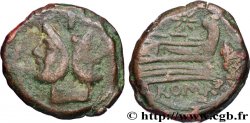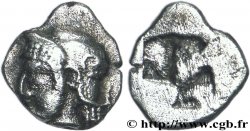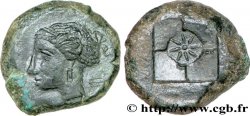v15_1457 - REPUBBLICA ROMANA - ANONIMO Didrachme
MONNAIES 15 (2002)
Начальная цена : 155.00 €
Назначить цену : 320.00 €
Цена реализации : 171.00 €
Количество ставок : 2
Максимальная предлагаемая цена : 280.00 €
Начальная цена : 155.00 €
Назначить цену : 320.00 €
Цена реализации : 171.00 €
Количество ставок : 2
Максимальная предлагаемая цена : 280.00 €
Тип Didrachme
Дата: c. 225-215 AC.
Монетный двор / Город: Rome ou Italie
Металл: silver
Диаметр: 21 mm
Ориентация осей монеты: 12 h.
Вес: 6,38 g.
Редкость: R1
Комментарии о состоянии
Beau portrait de Janus. Patine foncée de collection. Légèrement décentré au revers
Ссылки в каталоге: :
Происхождение:
Cet exemplaire provient d’une très vieille collection constituée avant la première Guerre mondiale
Лицевая сторона
Аверс: легенда: ANÉPIGRAPHE.
Аверс: описание: Tête imberbe de Janus.
Обратная сторона
Реверс: легенда: ROMA EN CREUX À L'EXERGUE DANS UN CARTOUCHE EN RELIEF.
Реверс: Описание: Jupiter dans un quadrige galopant à droite, conduit par la Victoire tenant les rênes, brandissant un foudre de la main droite et tenant un sceptre long de la gauche.
Комментарий
Ce type très ancien n’a certainement pas été copié directement par les Celtes. Néanmoins, le monnayage d’or des Médiomatriques (LT. 8933 et 8937) semble directement inspiré par le didrachme romano campanien. Certaines petites monnaies d’or au type de la tête de Janus (KO. 13 et 14) sont peut-être directement copiées sur le monnayage italo-punique de Capoue (GC. 287), frappé entre 216 et 211 avant J.-C. Il est possible que les statères à la double tête barbue (LT. 9899 = KO. 540-547) soit des adaptations libres du didrachme romain en passant par le prototype du tétradrachme de Philippe II de Macédoine. Faut-il rappeler que de nombreux mercenaires celtes servaient dans les différentes armées, grecques, carthaginoises, voire romaines et que ces hommes étaient soldés en monnayages locaux, et que d’autre part le pillage était largement répandu. Nos mercenaires pouvaient donc se retrouver avec de nombreux types différents qu’ils exportèrent vers leur nation d’origine. Ce type ne semble pas avoir inspiré les bronzes CAITIO (BN 2614-2619), pas plus que le bronze des Suessions (LT. 8106).
This very ancient type was certainly not directly copied by the Celts. Nevertheless, the gold coinage of the Mediomatrici (LT. 8933 and 8937) seems directly inspired by the Romano-Campanian didrachm. Some small gold coins with the Janus head type (KO. 13 and 14) are perhaps directly copied from the Italo-Punic coinage of Capua (GC. 287), struck between 216 and 211 BC. It is possible that the staters with the double bearded head (LT. 9899 = KO. 540-547) are free adaptations of the Roman didrachm via the prototype of the tetradrachm of Philip II of Macedon. It should be remembered that many Celtic mercenaries served in the various armies, Greek, Carthaginian, and even Roman, and that these men were paid in local coins, and that, on the other hand, pillaging was widespread. Our mercenaries could therefore end up with many different types that they exported to their home nation. This type does not seem to have inspired the CAITIO bronzes (BN 2614-2619), nor the bronze of the Suessiones (LT. 8106)
This very ancient type was certainly not directly copied by the Celts. Nevertheless, the gold coinage of the Mediomatrici (LT. 8933 and 8937) seems directly inspired by the Romano-Campanian didrachm. Some small gold coins with the Janus head type (KO. 13 and 14) are perhaps directly copied from the Italo-Punic coinage of Capua (GC. 287), struck between 216 and 211 BC. It is possible that the staters with the double bearded head (LT. 9899 = KO. 540-547) are free adaptations of the Roman didrachm via the prototype of the tetradrachm of Philip II of Macedon. It should be remembered that many Celtic mercenaries served in the various armies, Greek, Carthaginian, and even Roman, and that these men were paid in local coins, and that, on the other hand, pillaging was widespread. Our mercenaries could therefore end up with many different types that they exported to their home nation. This type does not seem to have inspired the CAITIO bronzes (BN 2614-2619), nor the bronze of the Suessiones (LT. 8106)







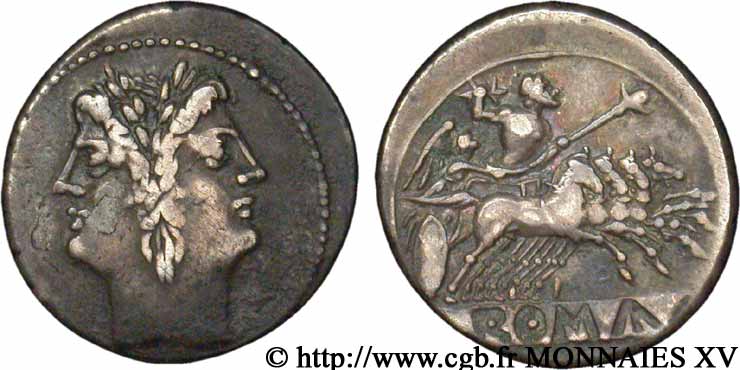
 Cообщить об ошибке
Cообщить об ошибке Распечатать страницу
Распечатать страницу Отправить мой выбор
Отправить мой выбор Задать вопрос
Задать вопрос Consign / sell
Consign / sell
 Информация
Информация


